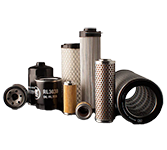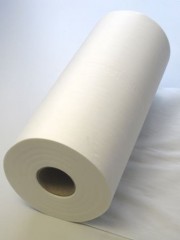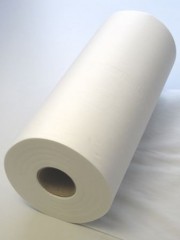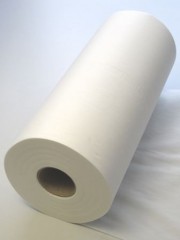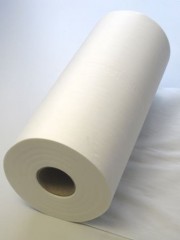No products available yet
Stay tuned! More products will be shown here as they are added.
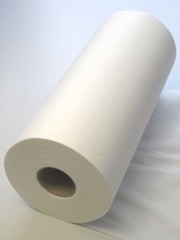

| Weight DIN EN 29073-1 |
Thickness DIN ISO 9073-2 |
Max. tensile strength dry DIN EN 29073-3 N / 5 cm |
Max. tensile strength wet DIN EN 29073-3 N / 5 cm |
Elongation dry DIN EN 29073-3 % |
|||
| (g/m²) | (mm) | length | across | length | across | length | across |
| 20 | 0,14 | 65 | 35 | 60 | 35 | 20 | 23 |
| 25 | 0,15 | 85 | 45 | 85 | 45 | 20 | 25 |
| 40 | 0,20 | 140 | 80 | 140 | 80 | 24 | 30 |
| 60 | 0,25 | 200 | 120 | 200 | 100 | 20 | 25 |
| 70 | 0,27 | 260 | 120 | 225 | 100 | 20 | 25 |
Polyester is a fibrous material produced using the melt spinning process
Polyester fibres can be produced in any cross-section, ranging from round, oval or angular hollow fibres right through to micro-fibres.
Resistant to climatic influences, (light-resistant and weatherproof)
Good mechanical characteristics such as elasticity, dimensional stability, dry and wet strength and abrasion resistance
Low moisture absorption
Good resistance to acids and solvents
Recycling: Mainly thermal

| Weight DIN EN 29073-1 |
Thickness DIN ISO 9073-2 |
Max. tensile strength dry DIN EN 29073-3 N / 5 cm |
Max. tensile strength wet DIN EN 29073-3 N / 5 cm |
Elongation dry DIN EN 29073-3 % |
|||
| (g/m²) | (mm) | length | across | length | across | length | across |
| 20 | 0,15 | 18 | 9 | 20 | 10 | 7 | 30 |
| 30 | 0,20 | 39 | 24 | 35 | 25 | 20 | 35 |
| 40 | 0,22 | 50 | 25 | 45 | 25 | 20 | 35 |
| 50 | 0,25 | 60 | 35 | 60 | 40 | 25 | 35 |
| 60 | 0,27 | 65 | 45 | 65 | 45 | 30 | 40 |
| 70 | 0,30 | 85 | 65 | 85 | 60 | 30 | 45 |

| Weight DIN EN 29073-1 |
Thickness DIN ISO 9073-2 |
Max. tensile strength dry DIN EN 29073-3 N / 5 cm |
Max. tensile strength wet DIN EN 29073-3 N / 5 cm |
Elongation dry DIN EN 29073-3 % |
|||
| (g/m²) | (mm) | längs | quer | längs | quer | längs | quer |
| 20 | 0,27 | 30 | 25 | 35 | 30 | 35 | 35 |
| 30 | 0,30 | 50 | 45 | 45 | 40 | 50 | 55 |
| 40 | 0,35 | 85 | 80 | 75 | 70 | 50 | 55 |
| 70 | 0,55 | 140 | 120 | 130 | 110 | 45 | 50 |

| Weight DIN EN 29073-1 |
Fibre structure | Thickness DIN ISO 9073-2 |
Max. tensile strength dry DIN EN 29073-3 N / 5 cm |
Max. tensile strength wet DIN EN 29073-3 N / 5 cm |
Elongation dry DIN EN 29073-3 % |
|||
| (g/m²) | (mm) | length | across | length | across | length | across | |
| 60 | 90% PES, 10% PP |
0,60 | 75 | 80 | 80 | 85 | 45 | 80 |
| 80 | 90% PES, 10% PP |
0,60 | 120 | 200 | 110 | 190 | 60 | 90 |
| 105 | 87% PES, 13% PP |
0,80 | 100 | 160 | - | - | 45 | 50 |
| 130 | 87% PES, 13% PP |
1,35 | 120 | 220 | 100 | 170 | 100 | 120 |
| 150 | 90% PES, 10% PP |
0,75 | 170 | 220 | 180 | 300 | 60 | 45 |
| 400 | 100% PES | 2,5 | 650 | 850 | 650 | 850 | 40 | 50 |
Setpoint values stated are average values subject to variations in the production process for nonwovens.

| Weight DIN EN 29073-1 |
Thickness DIN ISO 9073-2 |
Max. tensile strength dry DIN EN 29073-3 N / 5 cm |
Max. tensile strength wet DIN EN 29073-3 N / 5 cm |
Elongation dry DIN EN 29073-3 % |
|||
| (g/m²) | (mm) | length | across | length | across | length | across |
| 20 | 0,15 | 30 | 5 | 15 | 4 | 10 | 10 |
| 25 | 0,15 | 40 | 7 | 20 | 4 | 10 | 15 |
| 30 | 0,20 | 55 | 9 | 25 | 5 | 10 | 15 |
| 35 | 0,25 | 60 | 12 | 30 | 6 | 12 | 20 |
| 40 | 0,25 | 70 | 15 | 35 | 6 | 12 | 20 |
| 50 | 0,30 | 100 | 20 | 35 | 7 | 12 | 20 |
| 60 | 0,35 | 120 | 22 | 40 | 9 | 12 | 20 |
| 80 | 0,40 | 140 | 40 | 45 | 10 | 10 | 15 |
Stay tuned! More products will be shown here as they are added.
check_circle
check_circle
